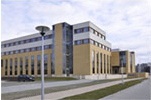5. The Monge-Ampère equation and the Kähler-Ricci flow
|
Polish supervisor:
|
S³awomir Ko³odziej
|
|
Cooperating partners:
|
Duong Phong (Columbia University)
Ahmed Zeriahi (Universitee Paul Sabatier, Toulouse)
|
One of the primary goals in Kähler geometry is to find canonical
(constant curvature) metrics on a given Kähler manifold. Those
objects play major role in modern physics. By solving the complex
Monge-Ampeere equation on compact Kähler manifolds one can
prove the existence of Kähler-Einstein metrics when the first
Chern class is negative or zero (Aubin-Yau and Calabi-Yau
theorems). Recently a lot of work is devoted to the study the
existence and regularity of the solutions to the equation when the
background metric is degenerate. One motivation comes from the
Kähler-Ricci flow theory when the solution gives the potential
of the limiting metric. This metric is a candidate for the
canonical metric in the absence of truly Kähler-Einstein
metrics. The similar equations occur when one considers Ricci-flat
metrics in a family of Kähler classes which approach the
boundary of the Kähler cone.
As for the tools used to study the Monge-Ampère equation on
compact Kähler manifolds the starting point is (some version of)
the Calabi-Yau theorem and its proof via the continuity method and
the maximum principle for elliptic equations. An alternative
method of finding the canonical metrics uses Kähler-Ricci flow,
as it was first done by Cao. However, while dealing with possibly
degenerate right hand side the methods of pluripotential theory,
based on properties of positive currents and capacities, come in
handy. In many recent papers on the subject those approaches are
combined.
The main aim of the project is to address a number of questions
concerning the existence and regularity of the Kähler-Ricci flow
under various assumptions on the underlying manifold, initial
metric and so on. Potentially, an important ingredient of such
proofs would be an efficient way of approximation any given
function plurisubharmonic with respect to a degenerate Kähler
metric by smooth functions of the same type. Similar questions can
be asked when instead of the limit of the Kähler-Ricci flow one
considers the limit of Ricci-flat metrics when their Kähler
classes degenerate.
|




|
|



